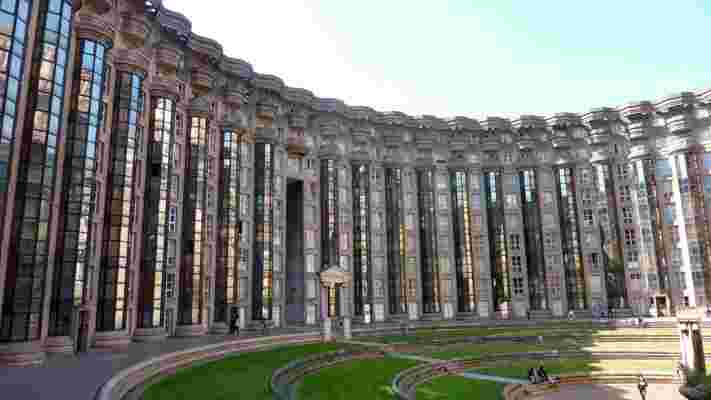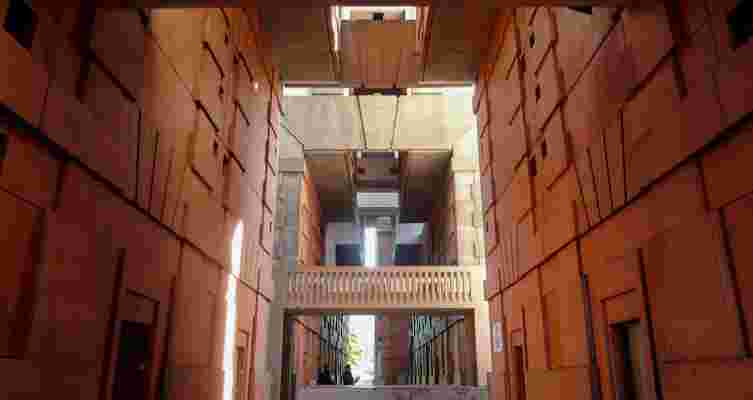The late architect Ricardo Bofill created structures that are the architectural equivalent of epic cinema—grand in scale, rich with provocative and occasionally scandalous ideas, and infused with implications about the past, present, and future. Spotting a kindred spirit, film directors frequently enlisted Bofill’s creations as backdrops that became as fundamental to story as any screenplay or performance.

The Theatre in the Espaces d’Abraxas in the Parisian suburb of Noisy-le-Grand.
Bofill, who died last month at age 82 , created giant housing developments that tweaked classical architecture, sinuous modern buildings with sensuous curves, angular apartment complexes that looked like premonitions of 8-bit video game graphics, and upcycled a crumbling factory into his own home and studio. One of the Barcelona native’s most famed projects, Les Espaces d’Abraxas in the 14th arrondissement of Paris, applied monumental architecture to a public housing project, creating something that was sweeping, ironic, and a little scary. Not many buildings can claim to be so cinematic. So striking and narrative was Les Espaces d’Abraxas that it played a key role in two major films about a future dystopia made nearly 40 years apart—one, among cinema’s most critically praised (1985’s Brazil) , the other, one of its most financially successful ( The Hunger Games—Mockingjay Part 2 ).

Espaces d’Abraxas.
It was clear that Bofill had more than aesthetics on the brain—he had an agenda. “The constant source of pleasure is space,” he said in a 2020 interview . “In the same way there is a pleasure for music, for sound, for vision, there is a pleasure for touch, and there is a pleasure for space. The notion of space-time is fundamental for creativity and for the present, to create not from a point of view, but to create in movement.”

Thandie Newton during a scene in Westworld shot at La Fábrica.
Many of Bofill’s works are the equivalent of a cinematic jump cut from the past to the future, a quality that directors of mystical and thematically weighty projects were eager to exploit. The third season of HBO’s Westworld used La Fábrica—the former cement factory that Bofill converted in 1975 into a 32,000-square-foot home and studio—to portray what its set designer called an “industrial-meets-postmodern-Gothic” set in a sweeping nightmare of a city on a hill. La Fábrica also provided a key location for 2019’s Paradise Hills , where it was transformed into a giant otherworldly estate cloaked in a garden that seemed to be reclaiming it.
La Fábrica.
Most recently, the smash hit Squid Game borrowed design elements from Bofill’s La Muralla Roja (1968–73)—a bright pink apartment complex in Spain that looks like a cross between a North African casbah and the arcade game Q-Bert (which wouldn’t be invented for more than a decade after construction began). In the dystopian Korean show, people compete in a series of deadly games in an attempt to win money to pay off their debts, and each day they have to a labyrinth of staircases resembling the building. (It has also been compared to M.C. Escher’s trompe l’oeil print, Relativity , from 1953.)
The Squid Game set that resembles Bofill’s La Muralla Roja.
There’s more than circumstantial evidence that Bofill thought in cinematic terms. He directed two films himself: Circles (1966) and Schizo (1970). Subtitled “fictional reportage about the architecture of the brain,” the latter involved actors depicting scenes of human worry and want. Schizo was the product of Bofill’s Taller de Arquitectura, a project that incorporated architects, urban planners, writers, and graphic designers.
“One of the reasons I have done architecture is to face the futility of life,” Bofill said in 2020. “I used to believe that through my work or accomplishments, I could leave a story that lasted beyond my life for 300 years. It was almost rhetorical. I do not think so anymore. I do not think the construction of a work surpasses you.”
There’s one thing he didn’t consider: If the buildings don’t last, their now-iconic presence in film makes it unlikely Bofill will be easily forgotten.

Leave a Reply